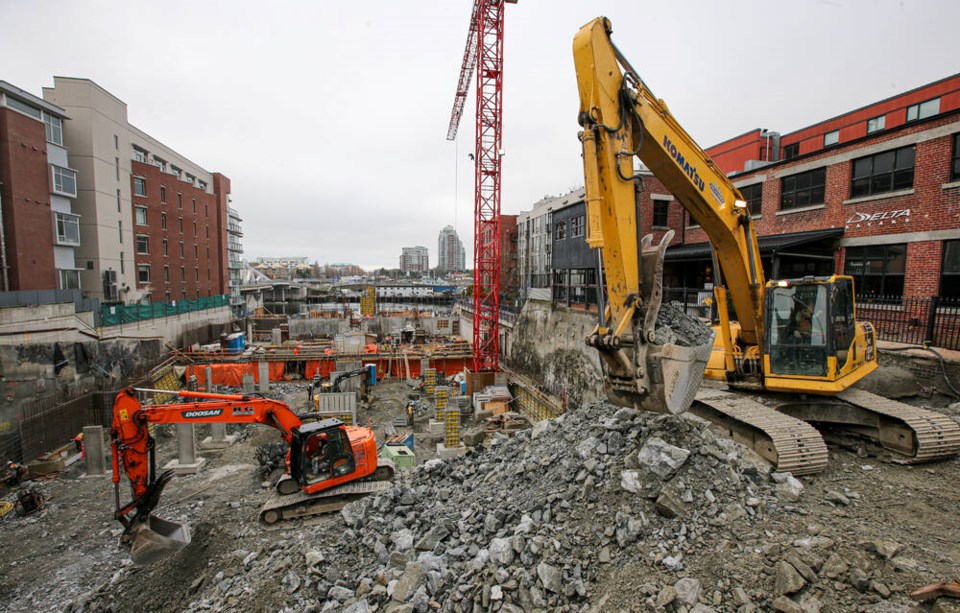Victoria’s residential construction sector broke a 45-year-old homebuilding record last year, but housing experts say even that is cold comfort in a region facing historically low inventory levels and ever-increasing demand.
According to the Canada Mortgage and Housing Corporation, homebuilders in the region started 4,809 new homes in 2021, eclipsing the record of 4,439 set in 1976, and burying 2020’s total of 3,209
Casey Edge, executive director of the Victoria Residential Builder’s Association said the numbers look good but the region is still digging itself out of a housing deficit.
“It’s just not enough to keep up with demand,” he said. “Over the decades, we’ve averaged around 2,200 new homes annually and last year we built more than double that.
“But we’re still talking about having low inventory numbers, so clearly the supply is not meeting the demand.”
The state of homebuilding in the region was top of the agenda Wednesday at the VRBA’s annual Crystal Ball housing forecast, which brings in experts to weigh in on the factors shaping the region’s housing industry.
Pershing Sun, senior analyst with CMHC, said the impressive number of new starts came in the face of strong headwinds from rising building costs, supply chain issues and an acute labour shortage.
Sun noted while many sectors have seen employment numbers improve since the early stages of the pandemic, the construction sector remains sluggish and has shed positions over the past year.
She said the headwinds mean the gap between starting and finishing a new home has increased, and given new-home absorption — the market snapping up newly finished homes — is over 90 per cent there is little hope housing inventory levels will improve this year.
“So the new home market may not loosen up until late 2023,” she said.
That is likely to lead to higher home prices again this year.
Brendon Ogmundson, chief economist with the B.C. Real Estate Association, said the average selling price for a home in Victoria is being forecast to be $1.01 million in 2022 and $1.04 million in 2023.
Ogmundson said the entire province faces a supply crisis. In Victoria, that is forecast to translate into an 18 per cent drop in the number of sales in the region, down from just over 10,000 sold last year.
Karen Dinnie-Smyth, president of the Victoria Real Estate Board, said while it is not in the prognostication business, the board sees no reason to expect big changes in the Victoria market in 2022.
“Essentially, our expectations are the same for 2022 as we saw in 2021,” she said, noting inventory is expected to remain at a record low while demand remains strong.
She said the buyers remain the same as well, with the vast majority local or from around B.C.
Dinnie-Smyth said it’s time to properly tackle the supply issue by improving permitting and rezoning procedures, and the province focusing on creating housing of all kinds, instead of on taxation measures and changing the sales process with things like cooling-off periods to manipulate supply.
Late last year, the province floated the idea of imposing cooling-off periods on home purchases to give buyers a limited amount of time to change their minds and cancel a purchase with little or no legal consequences.
The government claims the idea was to eliminate the pressure for buyers to put in unconditional offers, often without home inspections, in hopes of landing a new home.
The industry says cooling-off periods do little more than add a layer of complexity to the sales process.
Dinnie-Smyth said such a measure would not move the needle on creating housing supply.
Edge said builders could be doing more if they did not face extended delays and increased costs due to municipal processes.
“They have to be more efficient,” he said, noting a recent survey of builders found a simple, straightforward building permit required seven days in Langford and two months in Saanich. “We’re running into more and more inefficiency in a number of municipalities.”
It’s reflected in the building starts numbers.
Of the 4,809 starts last year 1,741 were in Langford, 1,204 were in Victoria and 440 were in Sooke.
Saanich, one of the largest municipalities, had just 376 starts.
“The builders will build as much as they’re permitted to, but the reality is the government controls the housing market,” said Edge.
“So, in order for us to accommodate the population growth, the government is going to have to become more efficient at all three levels, but mostly at the municipal level.”



